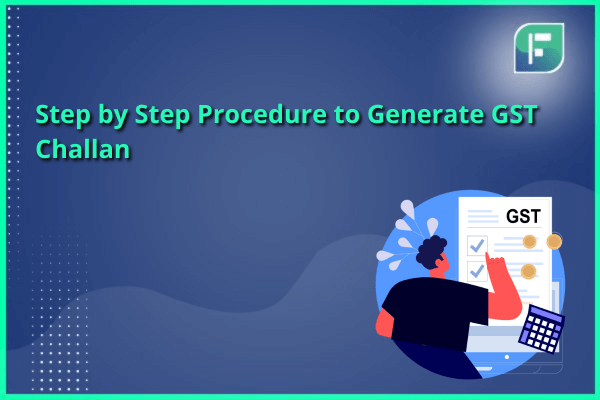Within the GST registration system, paying GST has become remarkably more convenient and straightforward with the introduction of the challan system and online transactions. Business owners find the new mechanism highly convenient as they can transfer the necessary funds through methods such as NEFT, RTGS, and Credit/Debit Cards.
To initiate a GST payment, a challan must first be generated from the GST portal. Subsequently, the payment can be executed using internet banking, credit/debit cards, NEFT, or through cash payment at selected banks. In this blog, we shall guide you through the procedure to generate GST challan and on completing the GST payment.
Methods for Making GST Payment
The methods for making GST payment have been mentioned below:
1. Internet Banking
One of the convenient methods for making GST payments is through internet banking provided by authorised banks. This method allows for a seamless and online transaction process.
2. Debit Card or Credit Card
Authorised banks also offer the option to make GST payments using debit or credit cards. This electronic mode of payment provides flexibility and ease of use for taxpayers.
3. National Electronic Fund Transfer or Real Time Gross Settlement
Taxpayers can opt for online payment through the National Electronic Fund Transfer (NEFT) or Real Time Gross Settlement (RTGS) systems, available in any bank. This electronic transfer method ensures a secure and efficient transaction process.
4. Over-the-Counter Payment
For deposits up to Rs. 10,000 per challan per tax period, taxpayers can make over-the-counter payments through authorised banks. This can be done using cash, cheque, or a demand draft, providing an alternative for those who prefer in-person transactions.
Authorised Banks for GST Payments
The government has authorised the following banks to accept GST payments on its behalf. These authorised banks facilitate a convenient and diverse range of payment options for GST, ensuring accessibility for taxpayers across the country. Taxpayers can generate a GST payment challan and make payments in cash, cheque, or demand draft at any of the listed banks:
1. Allahabad Bank
2. Bank of Andhra
3. Axis Bank
4. Bank of India
5. Bank of Baroda
6. Bank of Maharashtra
7. Canara Bank
8. Corporation Bank
9. Central Bank of India
10. Dena Bank
11. HSBC Bank
12. ICICI Bank Ltd.
13. IDBI Bank
14. Indian Overseas Bank
15. Indian Bank
16. Jammu and Kashmir Bank Limited
17. Sind Bank
18. Oriental Bank of Commerce
19. Punjab National Bank
20. Syndicate Bank
21. State Bank of India
22. UCO Bank
23. Vijaya Bank
24. United Bank of India
Procedure to Generate GST Challan
The procedure to generate GST challan has been mentioned below:
Step 1: Sign in to Your GST Account
To start the procedure to generate GST challan, sign in to your GST account on the portal. Upon reaching your dashboard, locate and click on the ‘Create Challan’ button.
Step 2: Enter GST Payment Details
Next in the procedure to generate GST challan, enter the details of the GST payment you intend to remit. Specify the amount under the CGST, IGST, Cess, and SGST heads. Additionally, provide a breakdown of the payment, indicating tax, fee, interest, penalty, and other relevant categories. Choose the preferred mode of payment from the available options. Once all required fields are completed, click on ‘Generate Challan.’
Step 3: Verify GST Payment Details
After clicking ‘Generate Challan,’ you will be redirected to a screen where you must verify the entered details. Confirm the accuracy of the information. Once verified, click on the ‘Make Payment’ button. If it’s a cash payment, a GST payment challan will be generated, which can be presented at an authorised bank for over-the-counter payment. This marks end of the procedure to generate GST challan.
In the procedure to generate GST challan, if you opt for online payment of the goods and services tax, thoroughly review all essential payment details. Ensure accurate calculations to avoid overpayment. Taking precautionary steps can prevent any discrepancies during the payment process.
Consequences of Not Filing a GST Return
The consequences for failing to file a GST return within the provided timeframe can result in both financial penalties and restrictions on subsequent filings.
1. Penalties for Late Filing:
- The government provides an extended window for late filings, but this comes at a cost.
- A penalty of Rs. 100 per day for GST and Rs. 200 per day of CGST or SGST is imposed for the duration of the delay.
- The cumulative penalty can reach up to Rs. 5,000.
2. Impact on Subsequent Filings:
- If the deadline for filing returns in a specific month is missed or forgotten, it has a cascading effect.
- Subsequent return filings are barred until the overdue return is filed, and the associated fines or penalties are settled.
It is important for businesses to adhere to the prescribed filing dates to avoid financial repercussions and disruptions in the filing process. Timely compliance not only ensures adherence to regulatory requirements but also helps maintain a smooth and uninterrupted flow of business activities.
Final Thoughts
The procedure to generate GST challan involves signing in to the GST portal, going to the dashboard, and selecting the ‘Create Challan’ option. Subsequently, the user enters details of the GST payment, specifying amounts under various heads. After providing a breakdown of the payment, including tax, fee, interest, penalty, and more, the user selects the mode of payment and clicks ‘Generate Challan.’ Verification of the entered details follows, and upon confirmation, users can make the payment. For cash payments, a GST payment challan is generated, which can be presented at authorised banks for over-the-counter transactions. This efficient process ensures efficient and accurate submission of GST payments.






